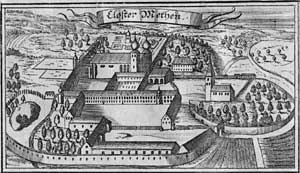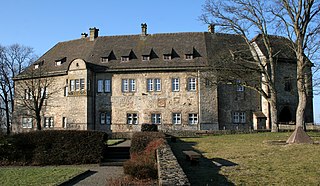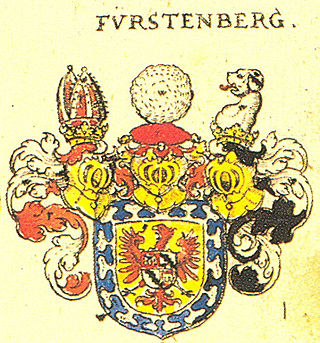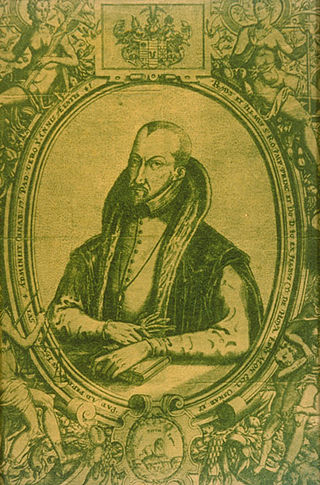
Paderborn is a city in eastern North Rhine-Westphalia, Germany, capital of the Paderborn district. The name of the city derives from the river Pader and Born, an old German term for the source of a river. The river Pader originates in more than 200 springs near Paderborn Cathedral, where St. Liborius is buried.

Erftstadt is a town located about 20 km south-west of Cologne in the Rhein-Erft-Kreis, state of North Rhine-Westphalia, Germany. The name of the town derives from the river that flows through it, the Erft. The neighbouring towns are Brühl, Kerpen, Zülpich and Weilerswist.

Nottuln is a municipality in the district of Coesfeld in the state of North Rhine-Westphalia, Germany.

Metten Abbey, or St. Michael's Abbey at Metten is a house of the Benedictine Order in Metten near Deggendorf, situated between the fringes of the Bavarian Forest and the valley of the Danube, in Bavaria in Germany.

Bad Driburg is a town and spa in Höxter district in North Rhine-Westphalia, Germany, situated on the river Aa and the Altenbeken–Kreiensen railway.

Franz Friedrich Wilhelm von Fürstenberg was a German politician and the most important statesman in the Principality of Münster in the second half of the 18th century. Fürstenberg was committed to a cautious and enlightened course of reform.

Göttweig Abbey is a Benedictine monastery near Krems in Lower Austria. It was founded in 1083 by Altmann, Bishop of Passau.

The House of Fürstenberg is the name of a German noble family of Westphalia, which descended from Hermannus de Vorstenberg. He was a liegeman of the Archbishop of Cologne, who was among the prince electors of the Holy Roman Empire. Hermannus held a castle for his lord called Fürstenberg at Ense-Höingen in Soest; this castle would give the family its name. His son was Wilhelm von Vorstenberg, the Justiciar and Castellan of Werl.

The Prince-Bishopric of Paderborn was an ecclesiastical principality (Hochstift) of the Holy Roman Empire from 1281 to 1802.

The Dreikönigsgymnasium is a regular public Gymnasium located in Cologne, Germany. Founded in 1450 by the city of Cologne, it is the oldest school in Cologne and one of the oldest in Germany. In 1556 it was transferred to Jesuit control through the son of the mayor, who had become a Jesuit. The Jesuits continued to run the school until 1778, when control was restored to the city after the papal suppression of the Jesuits of 1773.

Egon VIII of Fürstenberg-Heiligenberg was Imperial Count of Fürstenberg-Heiligenberg (1618–1635) and Bavarian Field-marshal, and an important military leader in the Thirty Years' War.

Ferdinand of Fürstenberg, contemporaneously also known as Ferdinandus liber baro de Furstenberg, was, as Ferdinand II, Prince Bishop of Paderborn from 1661 to 1683 and also Prince Bishop of Münster from 1678 to 1683, having been its coadjutor since 1667/68. He brought almost complete restoration to the Bishopric of Paderborn after the devastation of the Thirty Years' War.
Justus Wehmer was a German master builder of the Baroque era. He was the architect of the eighteenth century Hildesheim Cathedral and surrounding buildings. He was also responsible for the design of various town houses and manor houses in Westphalia.

Albo(no) (year of birth unknown - after 1177 in Freising) was from 1165 to 1169 the 28th Bishop of Passau.

Otto von Lonsdorf was a 13th-century Bishop of Passau.
Oliver of Paderborn, also known as Oliver Scholasticus or Oliver of Cologne, was a German cleric, crusader and chronicler. He was the bishop of Paderborn from 1223 until 1225, when Pope Honorius III made him cardinal-bishop of Sabina. He was the first Paderborn bishop to become a cardinal. Oliver played a significant role in the Crusades as a preacher, participant and chronicler.

A pilgrimage to a statue of Mary in Werl, North Rhine-Westphalia, Germany, caused the building of pilgrimage churches there. The first one, completed in 1662, was replaced by a Baroque building completed in 1789, which later became known as the Alte Wallfahrtskirche. When it became too small, an adjacent Wallfahrtsbasilika was built, dedicated to the Visitation. It was declared a Basilica minor in 1953.

Heinrich Bone was a German educator and hymnwriter. He wrote a reader for German studies which was used for higher education in Germany, Belgium, Luxembourg and Austria, until it was banned during the Kulturkampf. He published a hymnal, Cantate!, which was used by several Catholic dioceses and became a model for common hymnals. Some of his own hymns, including paraphrases of Latin hymns, are part of recent hymnals, both Catholic and Protestant, such as "Komm, Schöpfer Geist, kehr bei uns ein" as a paraphrase of the 9th-century hymn for Pentecost, Veni Creator Spiritus.

Johann IV of Osnabrück was a German nobleman and prince-bishop. From his father Johann VII's death in 1535 onwards he was known as Count (Graf) Johann VIII von Hoya zu Stolzenau. From 1553 he was Prince-Bishop of Osnabrück, then from 1566 Prince-Bishop of Münster and finally from 1568 administrator of the Bishopric of Paderborn.

Wilhelm Anton Freiherr von der Asseburg was a German clergyman and Prince-Bishop for the Roman Catholic Archdiocese of Paderborn. He was ordained in 1763 and appointed bishop in 1763.






















